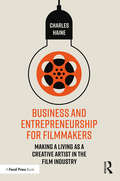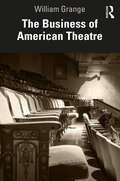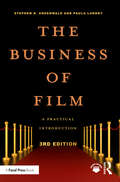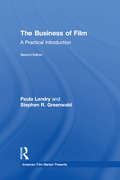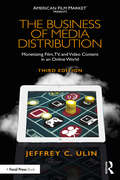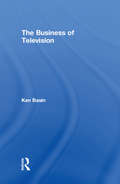- Table View
- List View
Business and Entrepreneurship for Filmmakers: Making a Living as a Creative Artist in the Film Industry
by Charles HaineThis practical guide teaches readers the skills and business acumen required to build a career in the film industry from the ground up. While countless books and classes teach newcomers the creative aspects of the film industry, many fail to properly prepare readers for the reality of how to navigate a freelance film career today. From creating a business model, dealing with taxes and funding, finding and managing clients, networking, investing, cashflow, and planning for the long-term, Business and Entrepreneurship for Filmmakers provides real-world, pragmatic advice on navigating a freelance film career, whether you’re a recent film school graduate looking to take the next step or a seasoned professional hoping to start a production company. Moreover, the skills taught here apply across the industry, from corporate media and commercials to music videos and feature films. Interviews with filmmakers, innovators, and business experts are included throughout the book to offer further expertise and examples.
Business and Entrepreneurship for Filmmakers: Making a Living as a Creative Artist in the Film Industry
by Charles HaineThis practical guide teaches readers the skills and business acumen required to build a career in the film industry from the ground up. While countless books and classes teach newcomers the creative aspects of the film industry, many fail to properly prepare readers for the reality of how to navigate a freelance film career today. From creating a business model, dealing with taxes and funding, finding and managing clients, networking, investing, cashflow, and planning for the long-term, Business and Entrepreneurship for Filmmakers provides real-world, pragmatic advice on navigating a freelance film career, whether you’re a recent film school graduate looking to take the next step or a seasoned professional hoping to start a production company. Moreover, the skills taught here apply across the industry, from corporate media and commercials to music videos and feature films. Interviews with filmmakers, innovators, and business experts are included throughout the book to offer further expertise and examples.
The Business Occupier's Handbook: A Practical guide to acquiring, occupying and disposing of business premises
by Clifford Chance Vicky RubinWhatever your type of business, this practical handbook will help you to manage your premises effectively. Whether you are a tenant or an owner-occupier, it will enable you to take an informed approach to commercial property, helping you to negotiate successful transactions, deal with ongoing management issues effectively and get the most from advisers and agents. The handbook takes a practical approach using worked examples and checklists. It provides a step-by-step guide to all the stages of occupation with comprehensive coverage of all the relevant legal and technical information, including: * strategic property management * financial analysis and decision making * negotiating strategy * valuaton * accounting * tax and business rates * acquisitions * purchase and lease terms * rent reviews * service charges * insurance * repairs alterations and use * planning and environmental issues* disposal of surplus space * lease expiries and renewals * compulsory purchase.
The Business Occupier's Handbook: A Practical guide to acquiring, occupying and disposing of business premises
by Clifford Chance Vicky RubinWhatever your type of business, this practical handbook will help you to manage your premises effectively. Whether you are a tenant or an owner-occupier, it will enable you to take an informed approach to commercial property, helping you to negotiate successful transactions, deal with ongoing management issues effectively and get the most from advisers and agents. The handbook takes a practical approach using worked examples and checklists. It provides a step-by-step guide to all the stages of occupation with comprehensive coverage of all the relevant legal and technical information, including: * strategic property management * financial analysis and decision making * negotiating strategy * valuaton * accounting * tax and business rates * acquisitions * purchase and lease terms * rent reviews * service charges * insurance * repairs alterations and use * planning and environmental issues* disposal of surplus space * lease expiries and renewals * compulsory purchase.
The Business of American Theatre
by William GrangeThe Business of American Theatre is a research guide to the history of producing theatre in the United States. Covering a wide range of subjects, the book explores how traditions of investment, marketing, labor union contracts, advertising, leasing arrangements, ticket scalping, zoning ordinances, royalties, and numerous other financial transactions have influenced the art of theatre for the past three centuries. Yet the book is not a dry reiteration of hits and flops, bankruptcies and bamboozles. Nor does it cover "everything about it that's appealing, everything the traffic will allow" (as Irving Berlin did in the song "There's No Business Like Show Business"). It is instead a highly readable resource for anyone interested in how money, and how much money, is critical to the art and artists of theatre. Many of those artists make appearances in the book: Richard Rodgers and his keen eye for investment, Jacob Shubert and his construction of "the bridge of thighs" for his showgirls at the Winter Garden, the significance of the Disney Souvenir Shop near the Lyceum Theatre on Broadway, and the difference between a Broadway show losing millions of dollars or making billions in one night. Consider this book a go-to resource for readers, students, and scholars of the theatre business.
The Business of American Theatre
by William GrangeThe Business of American Theatre is a research guide to the history of producing theatre in the United States. Covering a wide range of subjects, the book explores how traditions of investment, marketing, labor union contracts, advertising, leasing arrangements, ticket scalping, zoning ordinances, royalties, and numerous other financial transactions have influenced the art of theatre for the past three centuries. Yet the book is not a dry reiteration of hits and flops, bankruptcies and bamboozles. Nor does it cover "everything about it that's appealing, everything the traffic will allow" (as Irving Berlin did in the song "There's No Business Like Show Business"). It is instead a highly readable resource for anyone interested in how money, and how much money, is critical to the art and artists of theatre. Many of those artists make appearances in the book: Richard Rodgers and his keen eye for investment, Jacob Shubert and his construction of "the bridge of thighs" for his showgirls at the Winter Garden, the significance of the Disney Souvenir Shop near the Lyceum Theatre on Broadway, and the difference between a Broadway show losing millions of dollars or making billions in one night. Consider this book a go-to resource for readers, students, and scholars of the theatre business.
The Business of Architecture: Your Guide to a Financially Successful Firm
by Kathy Denise Dixon Timothy A. Kephart Karl L. MoodyThe Business of Architecture is the essential guide to understanding the critical fundamentals to succeed as an architect. Written by successful architects for architects everywhere, this book shows the architecture industry from a corporate business perspective, refining the approach to architecture as a personal statement to one that must design and build within the confines of business and clients. The Business of Architecture will educate new and experienced architects alike with valuable insights about profit centers, the architect as developer, how to respond to requests for proposals, intellectual property, and much more.
The Business of Architecture: Your Guide to a Financially Successful Firm
by Kathy Denise Dixon Timothy A. Kephart Karl L. MoodyThe Business of Architecture is the essential guide to understanding the critical fundamentals to succeed as an architect. Written by successful architects for architects everywhere, this book shows the architecture industry from a corporate business perspective, refining the approach to architecture as a personal statement to one that must design and build within the confines of business and clients. The Business of Architecture will educate new and experienced architects alike with valuable insights about profit centers, the architect as developer, how to respond to requests for proposals, intellectual property, and much more.
The Business of Beauty: Gender and the Body in Modern London
by Jessica P. ClarkThe Business of Beauty is a unique exploration of the history of beauty, consumption, and business in Victorian and Edwardian London. Illuminating national and cultural contingencies specific to London as a global metropolis, it makes an important intervention by challenging the view of those who-like their historical contemporaries-perceive the 19th and early 20th centuries as devoid of beauty praxis, let alone a commercial beauty culture.Contrary to this perception, The Business of Beauty reveals that Victorian and Edwardian women and men developed a number of tacit strategies to transform their looks including the purchase of new goods and services from a heterogeneous group of urban entrepreneurs: hairdressers, barbers, perfumers, wigmakers, complexion specialists, hair-restorers, manicurists, and beauty “culturists.” Mining trade journals, census data, periodical print, and advice literature, Jessica P. Clark takes us on a journey through Victorian and Edwardian London's beauty businesses, from the shady back parlors of Sarah “Madame Rachel” Leverson to the elegant showrooms of Eugène Rimmel into the first Mayfair salon of Mrs. Helena Titus, aka Helena Rubinstein.By revealing these stories, Jessica P. Clark revises traditional chronologies of British beauty consumption and provides the historical background to 20th-century developments led by Rubinstein and others. Weaving together histories of gender, fashion, and business to investigate the ways that Victorian critiques of self-fashioning and beautification defined both the buying and selling of beauty goods, this is a revealing resource for scholars, students, fashion followers, and beauty enthusiasts alike.
The Business of Beauty: Gender and the Body in Modern London
by Jessica P. ClarkThe Business of Beauty is a unique exploration of the history of beauty, consumption, and business in Victorian and Edwardian London. Illuminating national and cultural contingencies specific to London as a global metropolis, it makes an important intervention by challenging the view of those who-like their historical contemporaries-perceive the 19th and early 20th centuries as devoid of beauty praxis, let alone a commercial beauty culture.Contrary to this perception, The Business of Beauty reveals that Victorian and Edwardian women and men developed a number of tacit strategies to transform their looks including the purchase of new goods and services from a heterogeneous group of urban entrepreneurs: hairdressers, barbers, perfumers, wigmakers, complexion specialists, hair-restorers, manicurists, and beauty “culturists.” Mining trade journals, census data, periodical print, and advice literature, Jessica P. Clark takes us on a journey through Victorian and Edwardian London's beauty businesses, from the shady back parlors of Sarah “Madame Rachel” Leverson to the elegant showrooms of Eugène Rimmel into the first Mayfair salon of Mrs. Helena Titus, aka Helena Rubinstein.By revealing these stories, Jessica P. Clark revises traditional chronologies of British beauty consumption and provides the historical background to 20th-century developments led by Rubinstein and others. Weaving together histories of gender, fashion, and business to investigate the ways that Victorian critiques of self-fashioning and beautification defined both the buying and selling of beauty goods, this is a revealing resource for scholars, students, fashion followers, and beauty enthusiasts alike.
The Business of Fashion: Designing, Manufacturing, and Marketing - with STUDIO
by Leslie Davis Burns Kathy K. Mullet“No other book compares…This is the book students reference during their four years at university.” – Tara Konya, Southern New Hampshire University, USALearn how fashion lines are designed, manufactured, marketed, and distributed. The book covers the full supply chain – from textiles to fashion brand production – as well as supply chain management, and competitive strategies, so that you can be successful in your future career. Topics covered include sustainable design for a circular economy, 3-D printing, fashion entrepreneurship, disruptions in fashion calendars, supply chain transparency, impact of social media, growth and evolution of online retailing, expanded omnichannel strategies, and changes in international trade, among others. Case studies, a Career Glossary, and key terms help you connect concepts to practice. New to this Edition · Content addresses knowledge and skill guidelines in the Association to Advance Collegiate Schools of Business (AACSB) and Textile and Apparel Program Accreditation Commission (TAPAC) accreditation standards · Expanded discussions of sustainability, corporate social responsibility, and technology across the supply chains for fashion products· Updated and expanded industry examples and case studies, emphasizing fashion brand companies from around the world· A new Careers Glossary listing job titles and descriptions found throughout the fashion industry The Business of Fashion STUDIO Study smarter with self-quizzes featuring scored results and personalized study tips Review concepts with flashcards of essential vocabulary
The Business of Film: A Practical Introduction (American Film Market Presents)
by Stephen R. Greenwald Paula LandryThis updated third edition introduces readers to the business of film at every stage of the filmmaking lifecycle, from planning and production to financing, marketing, and distribution. Celebrated authors Stephen R. Greenwald and Paula Landry offer a practical, hands-on guide to the business aspects of this evolving industry, exploring streaming, development, financing trends, regional/global/online distribution, shifting business models, exhibition, multi-platform delivery, marketing, VR/AR, virtual production, accounting, and more. The book is illustrated throughout with sample financing scenarios and charts/graphics, and includes detailed case studies from projects of different budgets and markets. This new and expanded edition has been updated to reflect the new challenges facing the industry due to Covid-19 and how to navigate the new landscape of film financing and distribution. Other updates include coverage of new indie films and distributors, virtual production, the recent impact of global markets including the biggest streamers like Netflix, Apple and Amazon are how they are shaping the future of the business. This is essential reading for students looking for foundational knowledge of the film industry and guidance on how to successfully adapt to constant changes in the entertainment business. Extensive online support material accompanies the book including downloadable forms and templates, PowerPoint slides, quizzes and test banks, and other additional resources.
The Business of Film: A Practical Introduction (American Film Market Presents)
by Stephen R. Greenwald Paula LandryThis updated third edition introduces readers to the business of film at every stage of the filmmaking lifecycle, from planning and production to financing, marketing, and distribution. Celebrated authors Stephen R. Greenwald and Paula Landry offer a practical, hands-on guide to the business aspects of this evolving industry, exploring streaming, development, financing trends, regional/global/online distribution, shifting business models, exhibition, multi-platform delivery, marketing, VR/AR, virtual production, accounting, and more. The book is illustrated throughout with sample financing scenarios and charts/graphics, and includes detailed case studies from projects of different budgets and markets. This new and expanded edition has been updated to reflect the new challenges facing the industry due to Covid-19 and how to navigate the new landscape of film financing and distribution. Other updates include coverage of new indie films and distributors, virtual production, the recent impact of global markets including the biggest streamers like Netflix, Apple and Amazon are how they are shaping the future of the business. This is essential reading for students looking for foundational knowledge of the film industry and guidance on how to successfully adapt to constant changes in the entertainment business. Extensive online support material accompanies the book including downloadable forms and templates, PowerPoint slides, quizzes and test banks, and other additional resources.
The Business of Film: A Practical Introduction (American Film Market Presents)
by Paula Landry Stephen GreenwaldThe updated second edition of this text introduces readers to the business of film at every stage of the filmmaking lifecycle, from planning and production to distribution. Authors Paula Landry and Stephen R. Greenwald offer a practical, hands-on guide to the business aspects of this evolving industry, exploring development, financing, regional/global/online distribution, business models, exhibition, multi-platform delivery, marketing, film festivals, production incentives, VR/AR, accounting, and more. The book is illustrated throughout with sample financing scenarios and charts/graphics, and includes detailed case studies from projects of different budgets and markets. This new and expanded edition has further been updated to reflect the contemporary media landscape, including analysis on major new players and platforms like Netflix, Amazon, Google and Vimeo, shifting trends due to convergence and disruption from new technology, as well as the rise of independent distribution and emergent mobile and online formats. An eResource also includes downloadable forms and templates, PowerPoint slides, quizzes and test banks, and other additional resources.
The Business of Film: A Practical Introduction (American Film Market Presents)
by Paula Landry Stephen GreenwaldThe updated second edition of this text introduces readers to the business of film at every stage of the filmmaking lifecycle, from planning and production to distribution. Authors Paula Landry and Stephen R. Greenwald offer a practical, hands-on guide to the business aspects of this evolving industry, exploring development, financing, regional/global/online distribution, business models, exhibition, multi-platform delivery, marketing, film festivals, production incentives, VR/AR, accounting, and more. The book is illustrated throughout with sample financing scenarios and charts/graphics, and includes detailed case studies from projects of different budgets and markets. This new and expanded edition has further been updated to reflect the contemporary media landscape, including analysis on major new players and platforms like Netflix, Amazon, Google and Vimeo, shifting trends due to convergence and disruption from new technology, as well as the rise of independent distribution and emergent mobile and online formats. An eResource also includes downloadable forms and templates, PowerPoint slides, quizzes and test banks, and other additional resources.
The Business of Fine Art Photography: Art Markets, Galleries, Museums, Grant Writing, Conceiving and Marketing Your Work Globally
by Thomas WernerThis guide for aspiring and exhibiting photographers alike combines practice and concept to provide a roadmap to navigating, and succeeding in, the fine art photography marketplace locally, domestically, and internationally. Join former New York gallery owner, international curator, and fine art photographer Thomas Werner as he shares his experiences and insights from leading curators, gallerists, collectors, auctioneers, exhibiting photographic artists, and more. Learn how to identify realistic goals, maximize results, work with galleries and museums, write grants, develop strong nuanced imagery, and build a professional practice in a continually evolving field. Featuring dozens of photographs from international practitioners, and a robust set of resources, this book will ensure you have the tools to give you the opportunity for success in any marketplace. Whether you are a student, aspiring photographic or video artist, or a photographer changing careers, The Business of Fine Art Photography is your guide to starting and growing your own practice.
The Business of Fine Art Photography: Art Markets, Galleries, Museums, Grant Writing, Conceiving and Marketing Your Work Globally
by Thomas WernerThis guide for aspiring and exhibiting photographers alike combines practice and concept to provide a roadmap to navigating, and succeeding in, the fine art photography marketplace locally, domestically, and internationally. Join former New York gallery owner, international curator, and fine art photographer Thomas Werner as he shares his experiences and insights from leading curators, gallerists, collectors, auctioneers, exhibiting photographic artists, and more. Learn how to identify realistic goals, maximize results, work with galleries and museums, write grants, develop strong nuanced imagery, and build a professional practice in a continually evolving field. Featuring dozens of photographs from international practitioners, and a robust set of resources, this book will ensure you have the tools to give you the opportunity for success in any marketplace. Whether you are a student, aspiring photographic or video artist, or a photographer changing careers, The Business of Fine Art Photography is your guide to starting and growing your own practice.
The Business of Media Distribution: Monetizing Film, TV, and Video Content in an Online World (American Film Market Presents)
by Jeffrey C. UlinIn this updated edition of the industry staple, veteran media executive Jeff Ulin relates business theory and practice across key global market segments—film, television, and online/digital—providing you with an insider’s perspective that can't be found anywhere else. Learn how an idea moves from concept to profit and how distribution dominates the bottom line: Hollywood stars may make the headlines, but marketing and distribution are the behind-the-scenes drivers converting content into cash. The third edition: Includes perspectives from key industry executives at studios, networks, agencies and online leaders, including Fox, Paramount, Lucasfilm, Endeavor, Tencent, MPAA, YouTube, Amazon, and many more; Explores the explosive growth of the Chinese market, including box office trends, participation in financing Hollywood feature films, and the surge in online usage; Illustrates how online streaming leaders like Netflix, Amazon, Apple, YouTube, Hulu and Facebook are changing the way TV content is distributed and consumed, and in cases how these services are moving into theatrical markets; Analyzes online influences and disruption throughout the distribution chain, and explains the risks and impact stemming from changing access points (e.g., stand-alone apps), delivery methods (over-the-top) and consumption patterns (e.g., binge watching); Breaks down historical film windows, the economic drivers behind them, and how online and digital delivery applications are changing the landscape. Ulin provides the virtual apprenticeship you need to demystify and manage the complicated media markets, understand how digital distribution has impacted the ecosystem, and glimpse into the future of how film and television content will be financed, distributed and watched. An online eResource contains further discussion on topics presented in the book.
The Business of Media Distribution: Monetizing Film, TV, and Video Content in an Online World (American Film Market Presents)
by Jeffrey C. UlinIn this updated edition of the industry staple, veteran media executive Jeff Ulin relates business theory and practice across key global market segments—film, television, and online/digital—providing you with an insider’s perspective that can't be found anywhere else. Learn how an idea moves from concept to profit and how distribution dominates the bottom line: Hollywood stars may make the headlines, but marketing and distribution are the behind-the-scenes drivers converting content into cash. The third edition: Includes perspectives from key industry executives at studios, networks, agencies and online leaders, including Fox, Paramount, Lucasfilm, Endeavor, Tencent, MPAA, YouTube, Amazon, and many more; Explores the explosive growth of the Chinese market, including box office trends, participation in financing Hollywood feature films, and the surge in online usage; Illustrates how online streaming leaders like Netflix, Amazon, Apple, YouTube, Hulu and Facebook are changing the way TV content is distributed and consumed, and in cases how these services are moving into theatrical markets; Analyzes online influences and disruption throughout the distribution chain, and explains the risks and impact stemming from changing access points (e.g., stand-alone apps), delivery methods (over-the-top) and consumption patterns (e.g., binge watching); Breaks down historical film windows, the economic drivers behind them, and how online and digital delivery applications are changing the landscape. Ulin provides the virtual apprenticeship you need to demystify and manage the complicated media markets, understand how digital distribution has impacted the ecosystem, and glimpse into the future of how film and television content will be financed, distributed and watched. An online eResource contains further discussion on topics presented in the book.
The Business of Research: Knowledge and Learning Redefined in Architectural Practice (Architectural Design)
by Deborah Saunt Tom Greenall Roberta MarcaccioArchitectural research is being redefined in practice. Whereas once the value of a piece of research was solely measured by the number of citations it received by fellow academics, shifting funding models and new societal concerns are forcing academia to question its structure and this mode of evaluation. At the same time a wave of practitioners and new types of institutions, such as RMIT in Melbourne and the London School of Architecture (LSA), have been recasting architectural education and theoretical speculation within practice, turning the traditional architectural studio into a learning environment that adopts and adapts academic models, and starts to use architectural research as a potential source of business intelligence, as a means for self-generating future commissions and speculative opportunities that sometimes even shift the terrain of practice. This new focus on research in practice is indicative of a profession redefining its relevance and scope. This is destabilising the traditional roles of academia and practice by questioning their deep-rooted separation and demanding a new definition of the term ‘research’ with one that is relevant to both parties. This issue features contributions from architectural thinkers, researchers and a number of practitioners who are recasting academic speculation within their own studios. This not only redefines what is meant by research and what forms it takes, but also how it creates value for them, their clients, for the discipline as a whole and for the ultimate users of their designs. This helps us to understand how research might be deemed valuable beyond a purely academic context. Moreover, it raises significant questions in terms of opportunities and risks that arise when research is recast into the less regimented realm of practice. Contributors: Daniel Davis, Lionel Devlieger, David Green, Harriet Harris, Rory Hyde, Lara Kinneir, James Soane, Ziona Strelitz, Leon van Schaik, John Zhang Featured architects: Assemble, DSDHA, Foster + Partners, Iredale Pedersen Hook, OMA, Public Practice and Superflux.
The Business of Television
by Ken BasinIn this book, esteemed television executive and Harvard lecturer Ken Basin offers a comprehensive overview of the business, financial, and legal structure of the U.S. television industry, as well as its dealmaking norms. Written for working or aspiring creative professionals who want to better understand the entertainment industry — as well as for executives, agents, managers, and lawyers looking for a reference guide — The Business of Television presents a readable, in-depth introduction to rights and talent negotiations, intellectual property, backend deals, licensing, streaming platforms, international production, and much more. The book also includes breakdowns after each chapter summarizing deal points and points of negotiation, a glossary, a list of referenced cases, and a wealth of real-world examples to help readers put the material into context.
The Business of Television
by Ken BasinIn this book, esteemed television executive and Harvard lecturer Ken Basin offers a comprehensive overview of the business, financial, and legal structure of the U.S. television industry, as well as its dealmaking norms. Written for working or aspiring creative professionals who want to better understand the entertainment industry — as well as for executives, agents, managers, and lawyers looking for a reference guide — The Business of Television presents a readable, in-depth introduction to rights and talent negotiations, intellectual property, backend deals, licensing, streaming platforms, international production, and much more. The book also includes breakdowns after each chapter summarizing deal points and points of negotiation, a glossary, a list of referenced cases, and a wealth of real-world examples to help readers put the material into context.
The Business of Television: Updated and Expanded Second Edition
by Ken BasinIn this expanded and updated second edition, esteemed television executive and Harvard lecturer Ken Basin offers a comprehensive and readable overview of the business, financial, and legal structure of the U.S. television industry, as well as its deal-making norms.The Business of Television explores the basic structure and recent history of the television and streaming business, rights and talent negotiations, intellectual property, backend deals, licensing, international production, and much more. This expanded and updated second edition also features an in-depth exploration of the evolution of the streaming business, offers valuable new insights about negotiation, reflects the historic impacts of the 2020 Covid-19 pandemic and 2023 WGA and SAG-AFTRA strikes, addresses the intersection of artificial intelligence technology and intellectual property law, and provides a greater breadth and depth of technical material about a wide variety of common television deals. The book also includes breakdowns after each chapter summarizing major deal terms and points of negotiation, a significantly expanded glossary, an extensive list of referenced articles and cases, and a wealth of real-world examples to help readers put the material into context.Written for a diverse audience of working or aspiring creative professionals, executives, agents, managers, lawyers, and students, The Business of Television is the definitive reference guide for the ever-changing television industry.
The Business of Television: Updated and Expanded Second Edition
by Ken BasinIn this expanded and updated second edition, esteemed television executive and Harvard lecturer Ken Basin offers a comprehensive and readable overview of the business, financial, and legal structure of the U.S. television industry, as well as its deal-making norms.The Business of Television explores the basic structure and recent history of the television and streaming business, rights and talent negotiations, intellectual property, backend deals, licensing, international production, and much more. This expanded and updated second edition also features an in-depth exploration of the evolution of the streaming business, offers valuable new insights about negotiation, reflects the historic impacts of the 2020 Covid-19 pandemic and 2023 WGA and SAG-AFTRA strikes, addresses the intersection of artificial intelligence technology and intellectual property law, and provides a greater breadth and depth of technical material about a wide variety of common television deals. The book also includes breakdowns after each chapter summarizing major deal terms and points of negotiation, a significantly expanded glossary, an extensive list of referenced articles and cases, and a wealth of real-world examples to help readers put the material into context.Written for a diverse audience of working or aspiring creative professionals, executives, agents, managers, lawyers, and students, The Business of Television is the definitive reference guide for the ever-changing television industry.
The business of time: A global history of the watch industry (Studies in Design and Material Culture)
by Pierre-Yves DonzéWorld watch production today is concentrated in three countries: Switzerland, Japan and China. Former centres such as Great Britain, France, the United States and Russia saw the industrial manufacture of watches disappear from their territory during the twentieth century. How did this situation come about? The business of time aims to answer this question by presenting the first comprehensive history of the sector. It traces the evolution and transformation of the global watch industry from the mid-nineteenth century to the present day, highlighting the conditions that enabled watch production to expand across the globe and revealing how multinational companies gradually emerged to dominate the industry.
